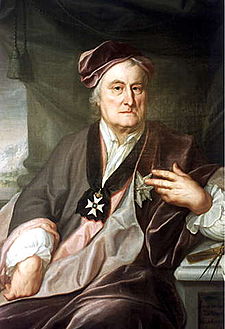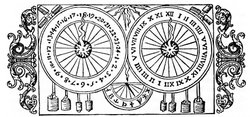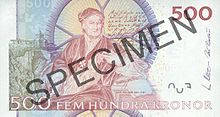- Christopher Polhem
-
Christopher Polhem 
Christopher Polhem, Johan Henrik Scheffel, 1741.Born December 18, 1661
Visby, Gotland, SwedenDied August 30, 1751 (aged 89)
Stockholm, SwedenResidence  Sweden
SwedenNationality  Swedish
SwedishFields Physics, Mechanics Alma mater Uppsala University
University of HarderwijkKnown for Göta Canal
Various inventionsChristopher Polhammar (December 18, 1661 – August 30, 1751), better known as
 Christopher Polhem (help·info), which he took after his ennoblement, was a Swedish scientist, inventor and industrialist. He made significant contributions to the economic and industrial development of Sweden, particularly mining.
Christopher Polhem (help·info), which he took after his ennoblement, was a Swedish scientist, inventor and industrialist. He made significant contributions to the economic and industrial development of Sweden, particularly mining.Contents
Biography
Polhem was born on the island of Gotland. His birth is not found in any official records such as church records, so the exact place of birth is unknown, but assumed to be Visby.
Originally the Polheim family came from Austria to Pomerania, Germany, from whence his father, Wolf Christoph Polhammer traded with Visby, where he would eventually settle down to become a skipper. When Polhem was 8, his father died and his mother, Christina Eriksdotter Schening from Vadstena, Östergötland remarried. As a result of conflicts with his stepfather, his private tuition was no longer paid for and Polhem was sent to live with his uncle in Stockholm. In Stockholm he attended a German school until the age of 12 when his uncle died; once again Polhem was left without the possibility of education.
He took a job as a farmhand on Vansta, a property in Södertörn, Stockholm. He quickly rose to the position of supervisor, being responsible for supervision and accounting, for which he was well suited by his affinity for mathematics. He worked at Vansta for ten years, during which period he constructed a workshop where he made tools, repaired and constructed simple machinery to earn money.
Hungering for knowledge within his fields of interest, mathematics and mechanics, he soon realized that he would get no further without learning Latin. Self-studies were attempted, but given up; Polhem realized he needed a tutor. In exchange for constructing a complex clock, he was given Latin lessons by a local vicar.
Word of Polhem's mechanical skill spread quickly and a member of the clergy wrote the professor of mathematics at Uppsala University, Anders Spole to recommend Polhem. Spole, grandfather of Anders Celsius, presented two broken clocks to Polhem and offered to let him study under him if he could repair them, Polhem repaired the clocks with no difficulty and began recovering years of lost education in 1687, at the age of 26.
He married Maria Hoffman in 1691, together they had two children, Gabriel and Emerentia.
In 1716 he was ennobled in gratitude of his services to the nation by the king and changed his name from Polhammar to Polheim, which he later changed to Polhem.
He and his son Gabriel Polhem were both elected members of the Royal Swedish Academy of Sciences in 1739, the year the Academy was founded.
Polhem died of natural causes in 1751 in Stockholm.
Career
Industrial
 16th century woodcut from the History of Olaus Magnus, purportedly depicting the astronomical clock in Uppsala Cathedral.
16th century woodcut from the History of Olaus Magnus, purportedly depicting the astronomical clock in Uppsala Cathedral.
According to Polhem's autobiography, the event that marked the beginning of his career was the successful repair of the unfinished medieval (16th century) astronomical clock by Petrus Astronomus at Uppsala Cathedral, which had remained unfinished and broken for more than a century.
In 1690 Polhem was appointed to improve upon the current mining operations of Sweden. His contribution was a construction for lifting and transporting ore from mines, a process that was rather risky and inefficient at the time. The construction consisted of a track system for lifting the ore, as opposed to wires; the construction was powered entirely by a water wheel. Human labor needed was limited to loading the containers. Being new and revolutionary, word of Polhem's work reached the reigning king, Charles XI who was so impressed with the work that he assigned him to improve Sweden's main mining operation; the Falun Copper mine.
Funded by the Swedish mining authority, Polhem traveled throughout Europe, studying mechanical development, he returned to Sweden in 1697 to establish laboratorium mechanicum in Stockholm, a facility for training of engineers, as well as a laboratory for testing and exhibiting his designs, it is considered to be the predecessor of The Royal Institute of Technology. The laboratory was later moved from Stockholm to Falun and from there to Stjärnsund. In 1748 the collection of models used in the laboratory was returned to Stockholm.
His greatest achievement was an automated factory powered entirely by water; automation was very unusual at the time. Built in 1699 in Stjärnsund, the factory produced a number of products, deriving from the idea that Sweden should export fewer raw materials and process them within their own borders instead. The factory was a failure; it met great resistance among workers who feared they would be replaced by machinery. Eventually most of the factory was destroyed in a fire in 1734, leaving only the part of the factory that produced clocks left. The factory continued producing clocks, known for their high quality and low price. Although the popularity of the clocks diminished during the beginning of the 19th century, clock-making continues to this day at Stjärnsund, still producing around twenty clocks of the Polhem design per year.
Another product from the factory was the Scandinavian padlock ("Polhem locks", Swedish: Polhemslås), essentially the first design of the variation of padlocks common today. Economically, the factory was unfeasible, but the king at the time, Charles XII, was supportive and gave Polhem freedom from taxes to encourage his efforts.
The factory of Stjärnsund was visited by one of his contemporaries, Carolus Linnaeus, who wrote about the factory in his diaries as Nothing is more optimistic than Stjärnsund ("Intet är spekulativare än Stjärnsund").
Polhem also contributed to the construction of Göta Canal, a canal connecting the east and west coasts of Sweden. Together with Charles XII of Sweden, he planned the construction of parts of the canal, particularly the canal locks in the 18th century; it was not to be finished until 1832, long after his death.
Other major contributions made by Polhem were the constructions of dry docks, dams and as mentioned before, canal locks, which he designed together with his assistant and friend, Emanuel Swedenborg.
Other fields
Polhem was not only active within the field of mechanics, he actively wrote essays concerning medicine, social criticism, astronomy, geology and economics.
Other accomplishments
- Can be found on the reverse of the 500 Swedish kronor bank note, the front having a portrait of Charles XI of Sweden
- Has several schools named after him.
- Has an award named after himself, the Polhem Prize (Polhemspriset), which is awarded to significant contributors to industry and construction engineering.
- Reinvented the Cardan joint under the name of "Polhem knot" (Polhemknut) independently of Gerolamo Cardano, the original inventor.
- Has a commemorative coin with his portrait on it, as well as a bust, which can be found in Visby.
- Organized machinery into a "mechanical alphabet" and provided examples of such. Of 80 models carved in wood, 32 are still in the collections of the National Museum of Science and Technology (Tekniska Museet) in Stockholm. Another 13 models of the "mechanical alphabet" are to be found in the Falun Mining Museum, Sweden.
See also
Other Reading
- Johnson, William A. Christopher Polhem, The Father of Swedish Technology (Hartford, CT Trinity College Press. 1963)
External links
- Pohlem featured on the 500 Swedish Kroner banknote.
- (Swedish) "Kanalbyggare" (Swedish)
- (Swedish) Biography at Tekniska museet (Swedish)
- (Swedish) Biography on the site of the town Stjärnsund
- (Swedish) History of watchmaking at Stjärnsund
- Numericana entry on Polhem's coat of arms which features the Pythagorean theorem.
 This article contains content from the Owl Edition of Nordisk familjebok, a Swedish encyclopedia published between 1904 and 1926, now in the public domain.Categories:
This article contains content from the Owl Edition of Nordisk familjebok, a Swedish encyclopedia published between 1904 and 1926, now in the public domain.Categories:- 1661 births
- 1751 deaths
- People from Gotland
- Swedish nobility
- Swedish inventors
- Swedish physicists
- Swedish businesspeople
- Uppsala University alumni
- University of Harderwijk alumni
- Members of the Royal Swedish Academy of Sciences
- 17th-century Swedish people
- 18th-century Swedish people
Wikimedia Foundation. 2010.


